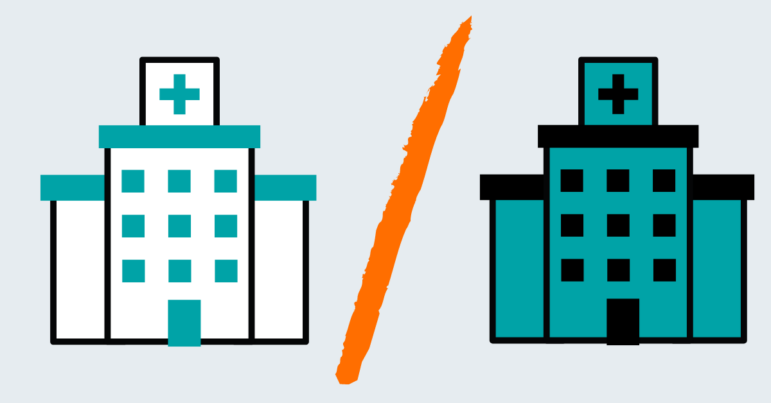Hospitals all over the country have struggled in the latest Covid-19 wave, facing an overwhelming number of patients, shortages of staff and PPE, and widespread moral injury. However, some hospitals have been affected much more strongly than others.
A recent feature article in The New York Times shows the experiences of clinicians and patients at one of the hardest-hit hospitals in Los Angeles during the winter Covid-19 surge, and the vast inequalities between the safety net institutions and other hospitals in the area.
M.L.K. hospital as a civic leader
Martin Luther King Jr. Community Hospital is a medium-sized, nonprofit safety net hospital in South Los Angeles, a dense, low-income neighborhood with few other health care resources available. Once a public hospital with a state health violations, the hospital was shuttered in 2007 and rebuilt in 2015 as a private nonprofit. Although the hospital can boast of having some of the most talented physician staff in the area, it is smaller and has fewer services than its predecessor: the new hospital has no elective surgeries, no pediatric care, and no trauma center, according to the Times report.
Before the pandemic, MLK hospital was serving far more people of color and low-income people compared to some of the large wealthy academic medical centers in the area. On the Lown Institute Hospitals Index, MLK received high scores for patient inclusivity and community benefit, while the “top” hospitals in Los Angeles (according to US News & World Report) scored close to the bottom.
Almost 100% of MLK hospital’s patient population were people of color, compared to a little more than one third at Ronald Reagan UCLA Hospital and Cedars Sinai. The average income of patients at UCLA is $72,000, compared to $41,000 at MLK.
| MLK Community Hospital | Ronald Reagan UCLA Hospital | Cedars Sinai Hospital | |
| Catchment area avg income | $46,000 | $59,000 | $59,000 |
| Patient avg income | $41,000 | $72,000 | $68,000 |
| Catchment area % people of color | 89% | 56% | 58% |
| Patient % people of color | 94% | 35% | 36% |
The differences in community benefit spending and Medicaid patients served are also stark. About three-quarters of MLK hospital’s patient revenue was from Medicaid patients, compared to just 10% at Cedars Sinai Hospital. MLK also spent about 5 times more than UCLA and Cedars Sinai on meaningful community benefits as a share of total expenses.
| MLK Community Hospital | Ronald Reagan UCLA Hospital | Cedars Sinai Hospital | |
| Meaningful community benefit spending as % of expenses | 5.6% | 0.6% | 1.1% |
| Medicaid patients as share of total patient revenue | 75% | n/a | 10% |
Los Angeles isn’t the only city with a segregated hospital system. New York City contains both the most inclusive and one of the least inclusive hospitals on the Index, less than five miles from each other. In many cities across the US, the most “elite” hospitals are among the least inclusive.
Why does this happen? Our health care delivery system is fragmented, divided between community hospitals (often public hospitals) and private ones. Private hospitals often cherry-pick wealthier patients with private insurance and avoid taking patients with public insurance, funneling poorer and sicker patients to the public hospitals. In the case of MLK hospital, only 4% of their patients have private insurance, according to the Times.
The pandemic wave
Even in an emergency like the Covid-19 pandemic, hospitals in some cities have not been pressured to work together. This lack of cooperation between hospitals has led to deadly disparities. At the peak of the Covid-19 surge, MLK had an extreme shortage of beds and staff, with 104 patients in an emergency room meant to hold just 29 beds. The hospital “literally felt like it was a war zone,” said Dr. Christopher Ortiz, a critical care specialist from UCLA who helped out at MLK, in the Times. “It was a form of critical care I’d never witnessed.”
The disparities in resources between MLK hospital and wealthier hospitals in the same area are huge. MLK does not have access to convalescent plasma (an approved treatment for early Covid-19) or ECMO (a treatment for seriously ill Covid-19 patients that gives the lungs a chance to rest). Other treatments, such as continuous dialysis and monoclonal antibodies, have been in very short supply, forcing the hospital to ration these resources.
Other hospitals, such as UCLA, had no shortages of these treatments. But despite the great need for help, MLK staff had trouble transferring patients to other hospitals. Why? “Nobody wants their insurance,” said Ortiz. This isn’t the first time this has happened in the past year; in May 2020, some California hospitals refused or delayed transfers of Covid-19 patients from rural Imperial County because they were insured by Medicaid or uninsured, according to the Wall Street Journal.
For those who have been fighting on the front lines in low-income communities, it is obvious that our segregated hospital system is creating significant harm. “We’ve created a separate and unequal hospital system and a separate and unequal funding system for low-income communities, and now with Covid, we’re seeing the disproportionate impact,” said MLK.’s chief executive, Dr. Elaine Batchlor in the Times.
